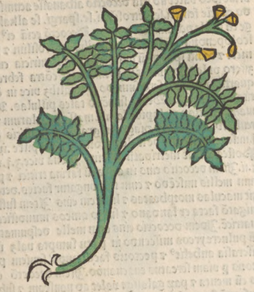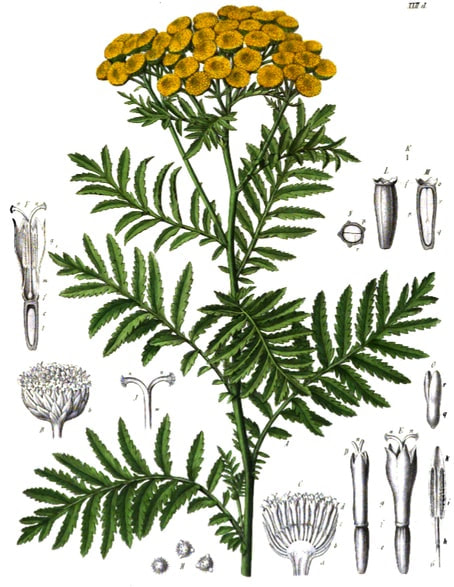Sentry Page Protection
Herbarius latinus, Petri, 1485
Darstellung und Beschreibung Pharmacopoea Borussica, Berg, 1861
Botanical name:
Tanacetum vulgare (syn. Chrysanthemum vulgare)
Two types were known: the sweet, and that without scent; the Sweet was divided into the common yellow, curly leaved, small white, and that from the Alps; that without scent is also either greater or lesser.
Parts used:
Herb; Seed
Temperature & Taste:
Warm, dry. Bitter, Pungent
Classifications:
2D ATTENUATERS OF CONGEALED BLOOD
3G. EMMENAGOGUE. 3Q. ANTHELMINTIC
4i. UTERINE
TCM:
S. Worms and Parasites
Tanacetum vulgare (syn. Chrysanthemum vulgare)
Two types were known: the sweet, and that without scent; the Sweet was divided into the common yellow, curly leaved, small white, and that from the Alps; that without scent is also either greater or lesser.
Parts used:
Herb; Seed
Temperature & Taste:
Warm, dry. Bitter, Pungent
Classifications:
2D ATTENUATERS OF CONGEALED BLOOD
3G. EMMENAGOGUE. 3Q. ANTHELMINTIC
4i. UTERINE
TCM:
S. Worms and Parasites
Uses:
1. Moves the Blood, Clears Stasis, Regulates Menstruation:
-stoppage of menstruation, scanty or painful menstruation, and ‘fits of the mother’.
-swelling or inflammation of the Uterus.
-as an abortifacient: ‘not so dangerous generally as that following the use of Nutmeg but very often serious’.
-An important traditional Wound herb; for bruising; a good application to sprains, swellings and inflammations.
2. Benefits the Womb, Prevents Miscarriage:
-traditionally regarded as useful during pregnancy, or to women who want children.
-threatened miscarriage from excess Heat and Blood stasis
-infertility from Blood stasis
3. Clears Damp, Promotes Urine:
-difficult, painful, incomplete or frequent urination;
-Edema and Gravel; Culpeper said it is good for Stones, especially in men.
-Leukorrhea.
-Jaundice
4. Clears Wind-Damp, Moves the Blood, Eases Pain:
-like its relative Feverfew it is used for Sciatica, Backache, Gout and other joint pain from Heat, Wind and Damp;
-Gerard said ‘the root preserved with Honey or Sugar is an especial thing against the Gout [Arthritis]’.
5. Clears Wind-Heat, Promotes Sweat:
-Cold, Flu, acute aches and pains, and Fevers.
-used similarly to Feverfew, but Feverfew is stronger for this function
6. Clears Damp, Promotes Digestion:
-indigestion, poor appetite;
-‘It cleanses the Stomach and Bowels of tough viscous phlegm, and other slimy humours which stick to them’ (Salmon);
-'wind and torments of the Belly'; abdominal pain, indigestion as well as Colitis and Irritable Bowel Syndrome.
7. Clears Phlegm, Stops Cough:
-Cough, excess Phlegm
8. Kills Worms:
-Pinworms, Tapeworm, Roundworm and Threadworm
-‘the seed of Tansy is a singular and proved medicine against Worms: for in what sort soever it be taken, it killeth and bringeth forth worms’ (A Niewe Herbal, Dodoens, 1578)
-infusion in Milk or decoction in Water has been used as an Enema for Worms
-insect repellent for Ants, Flies and Mosquitoes, among others.
9. Externally:
-‘cosmetic, to take off Freckles, Sun-burn and Morphew’ (Culpeper); the distilled water was used as a wash.
-inflammation, swelling or pain of the Eyes (decoction as a wash or distilled water topically)
-wash, bath or compress for Bruises, Sprains, Contusions, Dislocations, and all Contractures, Wounds, Ulcers
-oil is applied in liniments to Rheumatism and Joint Pain
-Varicose Veins as a compress, poultice etc.
-baths, washes etc. for Eczema and other Skin eruptions.
-toothache, Loose Teeth, Ulcers and Sores of the Mouth or Throat (as a wash or gargle)
Dose:
HERB in POWDER: ½–2, or 3 grams;
POWDERED FLOWERS: ½–1 gram (6–12 grains for Worms);
INFUSION or BRIEF DECOCTION of the HERB: 2–6 grams, up to 9 grams;
INFUSION or BRIEF DECOCTION of the SEED or FLOWER: 1½–4 grams (of the Seed for worms: up to 1 teaspoonful of the crushed seed has been used);
TINCTURE of the HERB (1:5 in 25% alcohol): 1–3, or 4 mls. To promote Menstruation, 10–12 drops may be given every 2 hours in warm water until bleeding begins;
FLUID EXTRACT (1:1 in 25% alcohol): 1–2 mls;
OIL of TANSY: 1–2 drops, up to 3 drops, taken on Sugar; from 5–10 drops or more have been used to Kill Worms, Promote Menstruation or Induce Abortion in strong adults; however the Oil must be used very cautiously, and should not generally be used in such large doses, if used at all. It should not be given to children.
HERB in POWDER: ½–2, or 3 grams;
POWDERED FLOWERS: ½–1 gram (6–12 grains for Worms);
INFUSION or BRIEF DECOCTION of the HERB: 2–6 grams, up to 9 grams;
INFUSION or BRIEF DECOCTION of the SEED or FLOWER: 1½–4 grams (of the Seed for worms: up to 1 teaspoonful of the crushed seed has been used);
TINCTURE of the HERB (1:5 in 25% alcohol): 1–3, or 4 mls. To promote Menstruation, 10–12 drops may be given every 2 hours in warm water until bleeding begins;
FLUID EXTRACT (1:1 in 25% alcohol): 1–2 mls;
OIL of TANSY: 1–2 drops, up to 3 drops, taken on Sugar; from 5–10 drops or more have been used to Kill Worms, Promote Menstruation or Induce Abortion in strong adults; however the Oil must be used very cautiously, and should not generally be used in such large doses, if used at all. It should not be given to children.
Main Combinations:
1. Amenorrhea, Dysmenoorhea:
i. Tansy with Feverfew
ii. Tansy with Feverfew and Mullein
iii. Tansy with Pennyroyal
iv. Tansy with Valerian, Rue, Rosemary
2. Chlorosis, Tansy with Mother of Thyme, Galeopsis (Becker)
3. To 'Purge' the Uterus, give half an ounce of the Powder with white wine. (The Secrets of Alexis, 1615)
4. Regulate Menstruation, Tansy with Ladies Mantle, Dead Nettle, Avens (Geum urbanum). (Kroeber)
5. To regulate the Uterus, cramping, pain, PMS,, Tansy, Valerian, Motherwort, Mugwort, Wormwood, Mint, Marjoram, Pennyroyal, Ginger, Saffron (as in Hysteric Water of Poterius)
6. Uterine pain, cramping, pain, amenorrhea and PMS, Tansy with Motherwort, Valerian, Mugwort, Wormwood, Mint, Marjoram, Pennyroyal, Ginger, Saffron (as in Hysteric Water of Poterius)
7. Gastritis, Enteritis, Colitis, Tansy with Coriander seed, Chicory, Water Cress, Gentian (Ulrich)
8. Dysuria, Tansy with Marshmallow, Juniper berry
9. Edema, chronic urinary disorders:
i. Tansy with Agrimony
ii. Tansy, Periwinkle, Agrimony
iii. Tansy, Wormwood, Juniper berry
10. Nephritis, Tansy with Uva Ursi, Dandelion, Wild Carrot, Marshmallow root, Pellitory of the Wall (Model Botanic Guide to Health)
11. Nervous disorders, Tansy with Peppermint, Rue, Wild Thyme, Marjoram, Thyme, Sage, Savin, Balm, Juniper (2 oz. each), Rose, Lavender (3 oz. each), Tansy flowers (4 oz.), Bay berries (2 oz.), Lesser Cardamon (1 oz.), Aniseed, Caraway seed (1 ½ oz. each), Mace (½ oz.). (Pharmacia rationalis, 1806)
12. Vertigo, Tansy with Rue, Valerian, Caraway (Dinand)
13. Worms:
i. Tansy with Wormseed
ii. Tansy with Wormwood and Camomile
iii. Tansy with Wormwood, Fern Root
iv. Tansy (10 parts) Pumpkin seed (70 parts) (Rose)
v. Tansy with Rue, Wormwood, Senna and Licorice
vi. Tansy, Valerian, Wormwood, Orange peel
vii. Tansy with Wormwood, Centaury, Gentian, Wormseed, Myrrh, Mint (Dispensatorium Pharmaceuticum, 1777)
viii. fresh Tansy leaf (1 part), Elecampane, Rhubarb, Wormseed (3 parts each), Madeira Wine (2 parts), Proof Spirit (20 parts). Infuse without heat for 8 days; express, filter. (Pharmacopee Usuelle, Louvain, 1821)
14. Fomentation for Worms (apply to abdomen) Tansy with Savin, Wormwood, Lavender
15. Trauma, Bruising:
i. Tansy decoction with a little salt added is drunk (The Secrets of Alexis, 1615)
ii. form an ointment with Tansy, Wormwood, Catnip, Horehound, Hops (as in Ointment for Trauma)
iii. form an ointment with Tansy, Rosemary, Lavender, Marjoram, Sage, Red Mint, Yarrow, Costus, Wormwood, St. Johns wort, Lesser Plantain, Agrimony (as in Ointment for Congealed Blood)
16. Inflammation of the Testicles, Tansy with Mallow, Marshmallow, Wormwood, Vervain and Cabbage. Seethe in old wine and use as a wash. Beat the herbs and apply as a paste. (The Secrets of Alexis, 1615)
Major Formulas
Ointment for Trauma
Ointment for Congealed Blood
Cautions:
1. Avoid overdose or long-term use.
2. Best not used during Pregnancy due to potential toxicity. Full doses cause miscarriage. However, it has been used for threatened miscarriage associated with Blood stasis. It must be used cautiously if used during pregnancy in low-to-moderate dose.
3. Not suitable for Yin deficiency
Toxicity:
The essential oil contains thujone which is toxic in overdose or long-term use. However, based on acute and chronic toxicity studies in animals, Tansy appears to have low toxicity in therapeutic doses. (see here)
Main Preparations used:
Distilled Water of the herb in flower, Distilled Oil (rarely)
1. Conserve of Tansy:
i. Tansy leaf, bruised (1 part), White Sugar (2 parts). Triturate together, heat gently in a water-bath. (Pharmacopee Usuelle, Louvain, 1821)
ii. Tansy flowers without calices (1 part), put into a copper pan over a gentle fire and gradually pour over them Syrup (2 parts). Stir until perfectly dry and repeat until the flowers are entirely covered in sugar. (Dispensatorium Fuldense, 1791)
2. Tincture of Tansy:
i. Tansy tops (1 part), Alcohol (4 parts). Digest 3 days in a moderate heat, express. Dose: 30–60 drops. (Dispensatorium Fuldense, 1791)
3. Tansy Water:
i. Tansy in flower (1 part), Water (8 parts). Distil 4 parts. (Pharmacia rationalis, 1806)
1. Avoid overdose or long-term use.
2. Best not used during Pregnancy due to potential toxicity. Full doses cause miscarriage. However, it has been used for threatened miscarriage associated with Blood stasis. It must be used cautiously if used during pregnancy in low-to-moderate dose.
3. Not suitable for Yin deficiency
Toxicity:
The essential oil contains thujone which is toxic in overdose or long-term use. However, based on acute and chronic toxicity studies in animals, Tansy appears to have low toxicity in therapeutic doses. (see here)
Main Preparations used:
Distilled Water of the herb in flower, Distilled Oil (rarely)
1. Conserve of Tansy:
i. Tansy leaf, bruised (1 part), White Sugar (2 parts). Triturate together, heat gently in a water-bath. (Pharmacopee Usuelle, Louvain, 1821)
ii. Tansy flowers without calices (1 part), put into a copper pan over a gentle fire and gradually pour over them Syrup (2 parts). Stir until perfectly dry and repeat until the flowers are entirely covered in sugar. (Dispensatorium Fuldense, 1791)
2. Tincture of Tansy:
i. Tansy tops (1 part), Alcohol (4 parts). Digest 3 days in a moderate heat, express. Dose: 30–60 drops. (Dispensatorium Fuldense, 1791)
3. Tansy Water:
i. Tansy in flower (1 part), Water (8 parts). Distil 4 parts. (Pharmacia rationalis, 1806)
Click the Tabs above for more information on this Medicine
From Culpeper:
‘Dame Venus was minded to pleasure Women with child by this herb, for there grows not an herb, fitter for there use than this; it is just cut out for the purpose. This herb bruised and applied to the navel, stays miscarriages; I know no herb like it for that use; Boiled in ordinary Beer and the Decoction drank doth the like, and if her Womb be not as she would have it, this Decoction will make it so. Let those Women that desire Children love this herb; it is their best companion, their Husbands excepted ... the very smell of it stays abortions or miscarriages’.
‘Dame Venus was minded to pleasure Women with child by this herb, for there grows not an herb, fitter for there use than this; it is just cut out for the purpose. This herb bruised and applied to the navel, stays miscarriages; I know no herb like it for that use; Boiled in ordinary Beer and the Decoction drank doth the like, and if her Womb be not as she would have it, this Decoction will make it so. Let those Women that desire Children love this herb; it is their best companion, their Husbands excepted ... the very smell of it stays abortions or miscarriages’.



